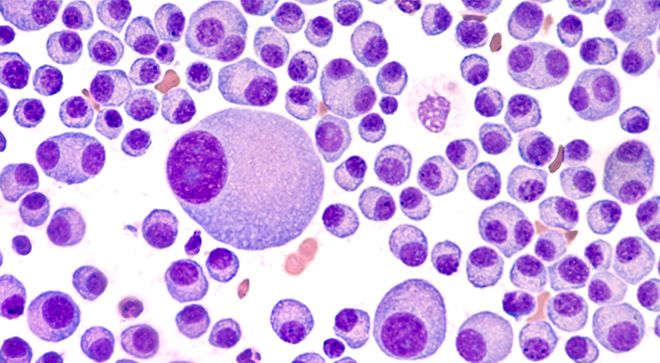News
Article
R/R MM Survival Improvements With Pomalyst Plus Velcade With Dexamethasone
Author(s):
Pomalyst plus Velcade with dexamethasone improves survival outcomes for patients with relapsed/refractory multiple myeloma, according to a phase 3 trial.

The treatment combination of Pomalyst (pomalidomide), Velcade (bortezomib) and dexamethasone (PVd) demonstrated a slightly better overall survival benefit compared with Velcade plus dexamethasone (Vd) in patients with relapsed/refractory multiple myeloma, according to a presentation from the 2023 International Myeloma Society (IMS) Annual Meeting.
Pomalyst is a drug that helps the immune system destroy cancer cells and may prevent the growth of new blood vessels tumors need in order to grow, according to National Cancer Institute.
Velcade is a drug that blocks or inhibits enzymes called proteasomes, which helps prevent cancer cells from growing and could destroy them, the National Cancer Institute explained. According to American Cancer Society, dexamethasone is a type of corticosteroid (steroid), in which is helps decrease nausea and vomiting caused by chemotherapy.
OPTIMISMM was an open-label, phase 3 trial that randomly assigned patients with relapsed/refractory multiple myeloma who had undergone one to three prior treatment regimens to receive either PVd or Vd.
Eligible patients also needed to have an ECOG performance status of 2 or lower and underwent at least two previous cycles of Revlimid (lenalidomide), a drug that helps the immune system destroy abnormal blood or cancer cells and may prevent the growth of new blood vessels that tumors need in order to grow, as stated by the National Cancer Institute.
Results from the phase 3 trial, presented during IMS, demonstrated the primary endpoint (main result measured at the end of a study to analyze efficacy of treatment) of progression-free survival (PFS, period during and after treatment when a patient lives with the disease but it does not worsen), and secondary endpoints.
Of note, secondary endpoints included overall survival (OS, length of time from diagnosis or the beginning of treatment when patients remain alive) and safety.
In terms of OS, there was a median follow-up of 64.5 months, which revealed that the 281 patients who received Pvd achieved a median OS of 35.6 months, versus 31.6 months among the 278 patients treated with Vd. The 36- (49% vs. 45%) and 72-month (26% vs. 23%) OS rates both slightly favored the PVd arm.
The median PFS in the PVd arm was 11.7 months compared with 6.9 months in the Vd cohort. The 36-month PFS rates were 20% vs. 7%, respectively, and the 72-month PFS rates were 10% vs. 2%, respectively. Overall, the researchers from the trial determined that patients treated with Pvd did experience a significantly longer median PFS, compared with those who received Vd.
“(Revlimind) refractoriness is a very general situation, which is seen when patients are exposed to (Revlimind) early in the course of the treatment,” Dr. Meral Beksaç, director of the department of hematology at Ankara University in Turkey, said during the presentation. “There’s a need for effective therapies in this setting.”
Treatment continued until disease progression or unacceptable toxicity. Patients who discontinued treatment because of worsening disease had a follow-up visit 28 days after discontinuation, and those who ceased treatment prior to disease progression entered into the PFS follow-up period.
“In the control arm, after progression, 58.3% of those patients received (Pomalyst), whereas in the triplet arm, only 19.2% of patients received (Pomalyst) (after progression),” Beksaç said.
In the safety population, 278 patients who received PVd had a median treatment duration of 41.2 weeks. In the Vd arm of 270 patients, the median duration of treatment was 21.4 weeks.
Further safety data in the PVd arm demonstrated that all patients experienced an any-grade treatment-related side effects. Common any-grade treatment-related side effects included infections and infestations (83%), neutropenia (lower amount of neutrophils, type of white blood cell) (54%) and fatigue (39%). Grade 3 or 4 treatment-related side effects occurred in 93% of patients and included neutropenia (47%), infections and infestations (35%) and thrombocytopenia (low platelet count in blood) (28%). Ten patients experienced grade 5 treatment-related side effects.
In the Vd arm, most patients experienced an any-grade treatment-related side effect (98%) and treatment-related side effects of grade 3 or 4 severity (72%). Any-grade treatment-related side effects included infections and infestations (66%), peripheral sensory neuropathy (nerve damage affecting touch, temperature and pain) (38%) and fatigue (27%). Grade 3 or 4 treatment-related side effects included thrombocytopenia (29%), infections and infestations (19%), and anemia (lower amounts of healthy red blood cells) (14%). Four patients in the Vd arm suffered grade 5 treatment-related side effects.
Treatment-related side effects leading to treatment discontinuation occurred in 33% of patients in the PVd cohort versus 20% of patients in the Vd cohort. Nervous system disorders (16% vs. 12%), general disorders and administration site conditions (4% vs. 1%), infections and infestations (4% vs. 2%), and respiratory, thoracic and mediastinal disorders (4% vs. less than 1%) led to treatment discontinuation in both cohorts.
Overall, 71% of patients died in the PVd cohort and 70% of patients died in the Vd cohort. Ten percent of deaths in the PVd cohort occurred during the treatment period, compared with 4% of deaths in the Vd cohort. Most patients in both arms (60% vs. 66%) died more than 28 days from the end of treatment.
For more news on cancer updates, research and education, don’t forget to subscribe to CURE®’s newsletters here.



